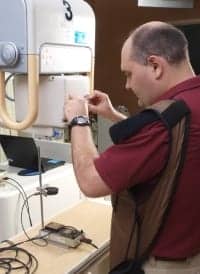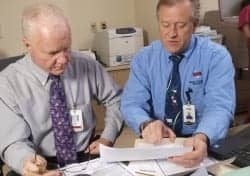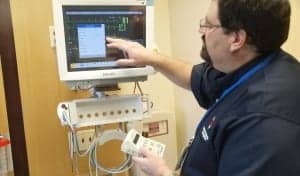“A corporation is organized as a system. It has this department, that department, that department … they don’t have any meaning separately. They only can function together,” David Joseph Bohm (1917–1992), quantum physicist.

Tom Nirschl, CBET, manager of the biomed operation at PVH, MCR, and other northern Colorado customers for HSS, works on a dialysis machine.
The clinical engineering team of Poudre Valley Health System (PVHS) in Fort Collins, Colo, is contracted through HSS, but has made interdepartmental teamwork the core of its philosophy, with some impressive results to show for the effort. In addition to cost savings and improved performance, its work with other departments throughout the PVHS health care system helped contribute to the organization’s receipt of a 2008 Malcolm Baldrige National Quality Award. Given by the president of the United States, the honor recognizes innovation and performance excellence.
Organizations are evaluated for the award according to criteria that review leadership; strategic planning; customer and staff focus; knowledge and process management; and clinical, regulatory, and financial results. Industries honored include manufacturing, service, small business, education, health care, and nonprofits.
In 2008, PVHS was one of three award recipients and the only health care organization selected for recognition. During an introductory speech at the award ceremony (held in 2009), United States Vice President Joe Biden stated that PVHS had “revolutionized health care.”
The work of the clinical engineering department was key to that “revolution,” in large part because of its Maintenance Management Fund, one of the (up to) 50 process improvements that the hospital could “brag about” within its application. That same program will be part of the hospital’s application again this year because it has continued to produce laudatory results. Savings reported in 2008 at roughly $336,000 climbed more than a third (37%) to $460,000 in 2010.
“Biomed has consistently created programs that have saved money, avoided costs, or managed activities more effectively,” says Tom Nirschl, CBET, medical equipment shop manager for HSS/PVHS.
Department Parts
“The nice thing about teamwork is that you always have others on your side,” Margaret Carty.
The HSS/PVHS clinical engineering department functions as one team to achieve its goals, though it is split physically between two shops: one at the 241-bed Poudre Valley Hospital (PVH) in Fort Collins, Colo, and a second within the 148-bed Medical Center of the Rockies (MCR), located in Loveland, Colo. The department is also responsible for nearly 30 smaller PVHS facilities, including clinics, as well as clients outside of the PVHS system.

Rob Pirrung, a sterilizer specialist for HSS, takes care of an OR light in the birthing center.
Clinical engineering at Poudre Valley falls under the information security (IS) umbrella of the health care system, an arrangement implemented in 2004. After the transition, the biomed department reported to the director of hardware and networking systems, but a recent organizational change now has Nirschl and his team directly reporting to the director of software applications and PACS.
The structure has worked well, and the individual departments function as one team. “There are no set guidelines on how much IS knowledge biomed needs or what work is done by the IS department versus biomed,” Nirschl says. “Because we are part of the structure of IS, we work side by side with a lot of the IS staff as issues come up.”
Nirschl leads the clinical engineering team, which includes a project manager, administrative specialist, and seven technicians—four based at PVH and three at MCR. Together, they handle the 16,000-device inventory that is spread throughout the group’s customers, both in-house and externally; external clients are managed through the same database and serviced out of the MCR shop.
Specialists from HSS cover the facilities’ sterilization equipment, OR tables, and OR lights; the company’s environmental health and safety division manages fume hoods, waste gas analysis, and other related services; and serious advanced imaging is on contract through outside firms (whether vendor or third party).
The HSS/PVHS clinical engineering team does handle some radiology first look calls as well as the service on x-ray units; and a few of the team members are specialists in the area. In general, however, the team utilizes a generalist approach. Where specialized education is not required (eg, IV pumps, vital signs monitors, light sources, oto-opthalmascopes, and other general equipment), team members can trade off tasks. When specialized training is needed (eg, contrast injectors, CR readers, central stations, monitoring systems, ventilators, etc), cross training will occur so there is some backup support.
To achieve and maintain this broad knowledge, the technicians generally seek training whenever possible, being sure to negotiate classes into capital investments (as has become standard with many other health care systems). If training is not an option, other educational routes are explored, including association training, such as through the Colorado Association of Biomedical Equipment Technicians.
“We try hard to find either specialties or types of equipment that enable us to do first response or full response to the benefit of the hospital or our customers,” Nirschl says. “In some cases, we can assist the hospital in negotiating training for this aim. In other cases, we can try to show that the return on investment justifies the cost of the training.”
Fund Managers

Kevin Harrell, CBET, CRES, shop lead at PVH and an imaging specialist for HSS, services a portable x-ray unit.
“Teamwork is the ability to work together toward a common vision. The ability to direct individual accomplishments toward organizational objectives. It is the fuel that allows common people to attain uncommon results,” Andrew Carnegie (1835–1919), entrepreneur, businessman, and philanthropist.
The clinical/biomedical engineering department plays a large role, in general, when it comes to acquisitions for PVHS, not just in regard to training and negotiation. Full cost of ownership is a major criterion for the evaluation of new acquisitions and capital investments, and biomeds can be best suited to provide an unbiased analysis. They are also the best suited to evaluate service and maintenance options, another significant budget line beyond the initial investment.
To develop the best strategy for this continuous outlay, clinical engineering works closely with the purchasing and materials management group, as well as the individual departments. “Purchasing and materials management gives us information throughout the year on what’s being purchased, what’s coming in, and what money is being allocated to new purchases,” says Randy Sullivan, CBET, SAVeR/Fund manager for PVHS. “During the budgeting period, many of the departments provide us with a list of what they think they can purchase that year.”
Sullivan oversees the effort to collect this information and determine what type of service is most appropriate for those purchases, given the resources and needs of the health care system and facility. “We want to find the right service from the right vendor at the right price,” Sullivan says.
Factors considered include operational time, critical role of the instrumentation (if any), and the number of devices that will be acquired. Options range from total in-house service, which requires proper training, to hybrid service solutions with OEMs or third parties, to vendor service agreements.
“Our ultrasound system is a good example of a mixed strategy,” Sullivan says. “Philips Healthcare [Andover, Mass] provides basic service; some of the PMs are handled in-house; and the probes are serviced, repaired, or replaced as needed through a third party.”
Once the facility acquires a system, it forecasts the costs over several years for the different layers of service, it allocates dollars from the department’s budget, and then places it into a general service fund. If an estimated replacement will be costly but is expected farther down the line, smaller amounts can be taken annually to build up the budget over time.
Clinical engineering manages the fund, which compiles the money allocated from all of the departments. Sullivan uses unique mathematical calculations to stay on top of risk, payouts, and surplus. “At the end of the year, if there is extra money, it goes back to the hospital,” Sullivan says.
Super SAVeRs

L-R: Jack Retzlaff, director of radiology at Medical Center of the Rockies, and Randy Sullivan CBET, asset manager for HSS at MCR, PVH, and other locations, review contract options for a service contract.
Thus far, there has been extra money, and it has continued to climb every year. The success is both a boon and a bother, and Sullivan sometimes worries that as the program expands, savings will be difficult to continue to generate—but not yet. “We’re still finding room for improvement, especially with the hospital growing so quickly,” Sullivan says.
The department improved the program by applying the strategy to existing contracts, not just new ones. An offspring of the Maintenance Management Fund looks at cost avoidance and savings, not as a procurement strategy, but as a perpetual effort. For instance, this year, the clinical engineering department negotiated new service agreements for equipment in the radiology oncology center that included a linear accelerator, MR, and CT equipment.
“We make sure we have the right source for specific parts or repairs, and we keep a critical eye on invoices coming in to ensure all charges are valid,” Sullivan says. The initiative has generated even greater savings than the original fund. “We’ve been creating about $600,000 in cost avoidance annually until last year, when we hit $1.2 million in savings. And this year, we’ve hit that number already,” Sullivan says.
Recognizing that smaller, independent, or stand-alone facilities could benefit just as much, if not more so, from such strategizing, the HSS/PVHS clinical engineering team developed another offshoot of the fund to target these groups: the Super SAVeR. “In the past, uninformed clinicians—who do not have a lot of time—would perform cursory research and often go with vendor recommendations, which might not match their needs,” Sullivan says. The clinician may have signed a “gold” contract, when he or she only needed a “silver” agreement or could have used an equally reliable but less expensive third party.
“Knowing the vast amount of agreements we manage, we set up a small research team within HSS to research these contracts and found we could renegotiate them with the same vendor or different vendors and guarantee two-to-one savings,” Sullivan says. The contracts often look the same as they do for larger facilities, but just need to be reworked to match the needs of the facility.
“Not only has it been successful at saving money on the front end, but the facilities have also found they receive better service,” Sullivan says. In addition, the clinicians have been freed from having to manage a task for which they lacked time and expertise to focus on caring for patients. The team now has nine clients in Colorado and one in Utah, ranging in size from nine beds to 50. “We found there is a critical need for this service, and it’s become a very popular program,” Sullivan says.
Team Players

Mark Sheets, CBET, shop lead at MCR for HSS, works on a monitor in an ICU step-down room.
The programs provide a huge benefit for the hospitals and other facilities the team serves, though they do create more work for the biomed department, which continues to perform typical service and maintenance work as well. This effort is also approached with an interdepartmental team effort.
“When an instrument goes down, we work with the department to find the best method to get it back into service as quickly as possible and minimize the downtime,” says Kevin Harrell, CBET, CRES, lead biomedical equipment technician at PVH.
Equipment is tracked through sterilization and repair with a multicopy tag system to document the process. “Here at MCR, the shop is located directly across from central supply, so they can easily drop instruments, like endoscopes, off for repair,” says Mark Sheets, CBET, biomed/lead tech.
Items are tracked within a spreadsheet that also includes whether a loaner is applicable; department heads can access the database from their desktops to check on equipment status and verify information. The process maximizes uptime, minimizes cost, and creates long-term efficiencies.
The team runs monthly reports for the departments detailing service but can also run on-demand reports that look at device performance or repair orders. If someone notices a repeat issue, a simple investigation can uncover the source of the issue.
“For instance, this morning, we have a very specialized sonic endoscope down for the third time. But the problem occurred at both MCR and PVH, so the problem wasn’t use-related,” Sullivan says. “We tracked it down to a defective repair by the manufacturer and are now obtaining a warranty repair at the savings of $9,000.”
Such results may contribute to another award for PVHS, Malcolm Baldrige or otherwise. While the accolades are nice, the real benefit lies in the performance improvement and cost savings experienced by the customers of the HSS/PVHS clinical engineering team—the physicians and the patients. Their needs are considered first, and the biomed team will work with any PVHS or HSS department to deliver smart solutions, and occasionally take a bow.
As author Matthew Woodring Stover stated, “If you take out the team in teamwork, it’s just work. Now who wants that?”
Renee Diiulio is a contributing writer for 24×7. For more information, contact .



